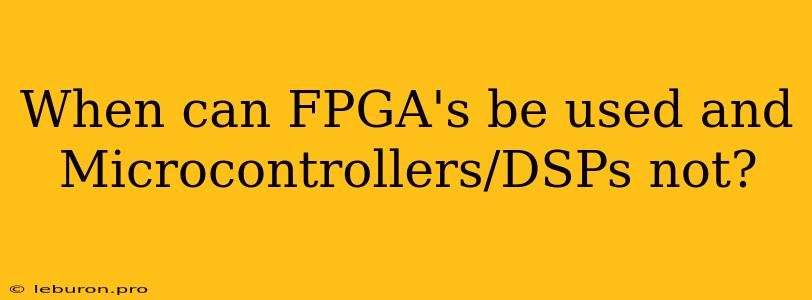Field-Programmable Gate Arrays (FPGAs) are versatile programmable logic devices that offer a high degree of flexibility and customization. They are often considered for applications where traditional microcontrollers and Digital Signal Processors (DSPs) might fall short. While both microcontrollers, DSPs, and FPGAs are powerful tools in embedded systems design, their strengths lie in different areas. This article explores when FPGAs offer a compelling advantage over microcontrollers and DSPs, delving into scenarios where their unique capabilities shine.
The Versatility of FPGAs: Beyond Traditional Computing
FPGAs stand apart from conventional processors by offering a fundamentally different approach to computation. Instead of executing instructions sequentially, as microcontrollers and DSPs do, FPGAs allow designers to configure hardware logic directly. This unique capability empowers engineers to create custom circuits tailored to specific applications, enabling them to achieve levels of performance and flexibility often unattainable with traditional processors.
Reconfigurability: Adapting to Evolving Needs
One of the most compelling advantages of FPGAs is their reconfigurability. This ability to modify the hardware design after manufacturing opens up a world of possibilities. Unlike fixed-function hardware, FPGAs can be updated and adapted as application requirements change, making them ideal for evolving systems or those with uncertain future needs.
High Throughput and Parallelism: Accelerating Computation
FPGAs excel in tasks that require high throughput and parallel processing. Their inherent parallel architecture enables them to handle multiple operations simultaneously, making them ideal for applications where speed is paramount. For instance, in image processing, FPGAs can be used to perform tasks like image filtering and edge detection at speeds far exceeding those achievable with traditional processors.
When to Choose an FPGA over a Microcontroller or DSP
The decision to use an FPGA over a microcontroller or DSP depends heavily on the specific application requirements. Here are some key scenarios where FPGAs offer a significant advantage:
1. High-Performance Applications with Strict Timing Requirements:
FPGAs are the preferred choice for applications with stringent timing constraints, such as high-speed data acquisition, control systems, and real-time signal processing. Their ability to perform operations in parallel and with minimal latency makes them well-suited for tasks requiring precise timing control.
Example: In a high-frequency trading system, where microsecond delays can impact profits, FPGAs can ensure the fastest possible response times for market data analysis and order execution.
2. Custom Hardware Design for Specialized Functionality:
FPGAs allow for the creation of custom hardware circuits tailored to specific application needs. This flexibility is particularly valuable when dealing with unique algorithms, unusual data formats, or specialized protocols.
Example: In medical imaging, FPGAs can be used to implement custom algorithms for image reconstruction, enabling faster and more accurate image processing.
3. Adaptable Solutions for Evolving Requirements:
The reconfigurability of FPGAs allows for on-the-fly modifications to the hardware design. This feature is invaluable for applications that might require changes over time, such as research prototypes, experimental systems, or those with evolving performance needs.
Example: In robotics, FPGAs can be used to implement real-time control algorithms that can be modified as the robot's capabilities are upgraded or its environment changes.
4. High-Speed Data Acquisition and Processing:
FPGAs excel at handling high volumes of data at high speeds. Their parallel architecture and low latency make them ideal for applications like data acquisition from sensors, high-resolution image processing, and real-time data analysis.
Example: In telecommunications, FPGAs are widely used for high-speed data routing, packet processing, and network security.
Comparing FPGAs with Microcontrollers and DSPs
While FPGAs offer compelling advantages in specific scenarios, they also have trade-offs compared to microcontrollers and DSPs. Here's a comparison highlighting their key differences:
| Feature | Microcontroller | DSP | FPGA |
|---|---|---|---|
| Programming Model | Sequential instruction execution | Specialized instructions for signal processing | Hardware configuration |
| Flexibility | Limited | Moderate | High |
| Parallelism | Limited | Moderate | High |
| Cost | Generally lower | Moderate | Typically higher |
| Power Consumption | Generally lower | Moderate | Can be higher |
| Development Tools | Extensive and mature | Specialized for signal processing | Can be more challenging |
Key Considerations for Choosing the Right Technology
Choosing the right technology—FPGA, microcontroller, or DSP—depends on the specific application requirements. Consider the following factors when making your decision:
- Complexity of the Algorithm: If the application involves complex algorithms with high computational demands, FPGAs might be the best choice.
- Timing Requirements: For applications with strict timing constraints, FPGAs offer the lowest latency and high throughput.
- Hardware Customization: If the application requires custom hardware design or flexibility, FPGAs provide the most options.
- Development Time: The development process for FPGAs can be more time-consuming and challenging compared to microcontrollers and DSPs.
- Cost and Power Consumption: FPGAs typically have higher costs and power consumption compared to microcontrollers and DSPs.
Conclusion: Leveraging the Strengths of FPGAs
FPGAs are powerful tools that provide a unique approach to computation, offering flexibility, high performance, and adaptability. They are particularly well-suited for applications demanding high throughput, parallel processing, and custom hardware design. When faced with challenging tasks that push the limits of traditional processors, FPGAs offer a compelling alternative, enabling developers to create innovative and efficient solutions. Choosing the right technology for your application requires careful consideration of the specific requirements and trade-offs involved. By understanding the strengths and limitations of FPGAs, microcontrollers, and DSPs, you can make informed decisions to optimize your embedded system designs.
